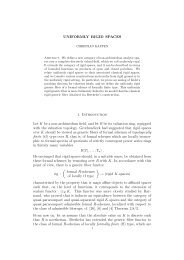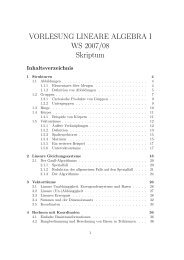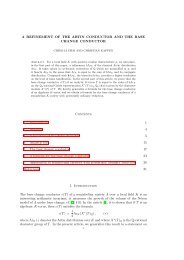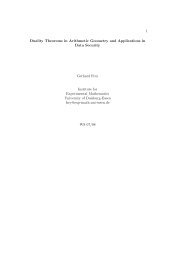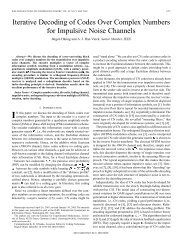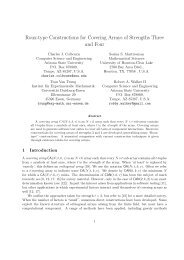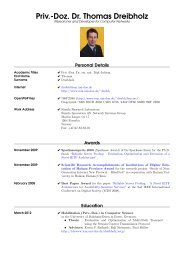Remark 38 If L ∈ Lat F is any lattice, then we had seen above that q L naturallydefines a GL 2 (Z)-equivalence class <strong>of</strong> positive binary quadratic forms. As is wellknown,one can also associate to L an SL 2 (Z)-equivalence class <strong>of</strong> forms by restrictingthe set {q L,α,β } to those forms that arise from oriented bases {α, β} <strong>of</strong> L, i.e. those forwhich Im(β/α) > 0 (where we view F ⊂ C). Thus, if we write cq + L = {cq L,α,β : L =Zα + Zβ, Im(β/α) > 0}, for c ∈ N and L ∈ Lat F , then it is well-known that the ruleI ↦→ ˜q + I := [R(I) : R ∆]q + Iinduces a bijectionq ∆ : Id(R ∆ )/≃ ∼ → Q ∆ /SL 2 (Z)between the set <strong>of</strong> isomorphism classes <strong>of</strong> non-zero ideals <strong>of</strong> the order R ∆ <strong>of</strong> discriminant∆ < 0 and the set <strong>of</strong> proper equivalence classes <strong>of</strong> positive binary quadraticforms <strong>of</strong> discriminant ∆.Now if we combine this bijection with the bijection I + Edefined in Corollary 19,then we obtain a bijectionq + E : Isog+ (E/K)which is given by the formula∼→ Id(End(E))/≃∼ → Q ∆E /SL 2 (Z)(82)q + E,E:= q + ′ E (E′ ) = q ∆E (I E (E ′ )) = [R(I E (E ′ )) : R E ]q + I E (E ′ )= f Eq + If E ′ E (E ′ ) ,where the last equality follows from the second equation <strong>of</strong> (50).On the other hand, if f E ′|f E , then equation (79) tells us thatq E,E ′ ∼ q E ′ ,E ∼ f Eq IE (Ef ′ ) and ∆(q E ′ ,E) = ∆ E .E ′Comparing this with (82), we therefore obtain the important relation that(83)q E,E ′ ∼ q + E,E ′ , for E ′ ∈ Isog + (E/K),where, as before, the symbol ∼ (for quadratic forms) means GL 2 (Z)-equivalence. Note,however, that q + E,Edenotes a proper (or SL ′2 (Z))-equivalence class <strong>of</strong> quadratic formsand hence is a finer invariant than the GL 2 (Z)-equivalence class q E,E ′. In fact, itfollows from the above that if E ′ , E ′′ ∈ Isog + (E/K), then we have thatq E,E ′ ∼ q E,E ′′ ⇔ I E (E ′′ ) ≃ I E (E ′ ) or I E (E ′′ ) ≃ I E (E ′ ) −1 ,and so there are two non-isomorphic <strong>elliptic</strong> <strong>curves</strong> in Isog + (E/K) which have thesame form q, except when q is ambiguous, i.e. when I E (E ′ ) ≃ I E (E ′ ) −1 .32
Corollary 39 Let E 1 /K and E 2 /K be two isogenous a <strong>CM</strong> <strong>elliptic</strong> <strong>curves</strong> withEnd 0 (E i ) ≃ F . If f i = f Ei , then(84)∆(q E1 ,E 2) = lcm(f 1 , f 2 ) 2 ∆ F and cont(q E1 ,E 2) = lcm(f 1, f 2 )gcd(f 1 , f 2 ) .Pro<strong>of</strong>. By Proposition 36 there is a <strong>CM</strong> <strong>elliptic</strong> curve E such that E ∼ E i and f Ei |f E ,for i = 1, 2. Thus E i ∈ Isog + (E), for i = 1, 2, and so the assertion follows fromProposition 37.4 Product abelian varieties4.1 Kernel ideals and ideal subgroups <strong>of</strong> A nLet A = A 1 × A 2 × . . . × A n be the product <strong>of</strong> the abelian varieties A 1 , . . . , A n /K, andlet p A i : A → A i denote the ith projection and e A j : A j → A be the jth inclusion map.If A ′ = A ′ 1 × A ′ 2 × . . . × A ′ m is another product abelian variety, then (as is well-known)the group Hom(A, A ′ ) can be identified with a set <strong>of</strong> m×n “matrices”. More precisely,we have the isomorphismT A,A ′ : Hom(A, A ′ )∼→ M(A, A ′ ) :=m⊕ n⊕Hom(A j , A ′ i)i=1 j=1given by the rule T A,A ′(h) = (h ij ), where h ij = p A′i ◦ h ◦ e A j ∈ Hom(A j , A ′ i). Weshall refer to the elements <strong>of</strong> M(A, A ′ ) as “matrices”. Note that this identification ismultiplicative in the sense that if A ′′ = A ′′1 × . . . × A ′′t is another abelian product, thenwe have the rule(85)T A,A ′′(h ′ ◦ h) = T A ′ ,A ′′(h′ ) · T A,A ′(h), if h ∈ Hom(A, A ′ ), h ′ ∈ Hom(A ′ , A ′′ ),where the product on the right hand side is the product <strong>of</strong> “matrices” which is definedby the rule (h ′ ik )(h kj) = (h ′′ij), where h ′′ij = ∑ k h′ ik ◦ h kj. This follows easily fromthe identity ∑ nk=1 eA′ k pA′ k = 1 A ′. In particular, if A = A n 1, then T A,A defines a ringisomorphismT A1 ,n = T A,A : End(A n 1)∼→ M(A n 1, A n 1) = M n (End(A 1 ))between End(A n 1) and the ring <strong>of</strong> n × n matrices with coefficients in the ring End(A 1 ).In order to study abelian varieties which are isogenous to A = A n 1, we shall usethe theory <strong>of</strong> kernel ideals and ideal subgroups <strong>of</strong> section 2. For this, we need tounderstand the ideals <strong>of</strong> M n (R), where R = End(A 1 ). To construct such ideals, weshall use the following notation.33
- Page 1: Products of CM elliptic curves1 Int
- Page 7 and 8: Indeed, if If is a kernel ideal, th
- Page 9 and 10: Indeed, by (18) we have I 1 f = I 2
- Page 11 and 12: Proof. To prove (29), let h ∈ Hom
- Page 13 and 14: 2.4 The quadratic caseWe now specia
- Page 15 and 16: ecause here f 2 |f 1 , so f = f 2 a
- Page 17 and 18: For this, put f = [R ′ : R], I =
- Page 19 and 20: From (54) we can conclude that(55)d
- Page 21 and 22: If H is any finite subgroup scheme
- Page 23 and 24: E. As we shall see, it is very illu
- Page 25 and 26: From this we see on the one hand th
- Page 27 and 28: Proposition 30 Let L ∈ Lat F , wh
- Page 29 and 30: (b) Deuring[10], p. 263. Note that
- Page 31: integral quadratic formq L,α,β (x
- Page 35 and 36: Proof. Write π i = π Hi : A → A
- Page 37 and 38: (a) The order R is cyclic if and on
- Page 39 and 40: for k = 1, . . . , n − 2. Moreove
- Page 41 and 42: 4.3 Products of CM elliptic curvesW
- Page 43 and 44: Corollary 56 Let E/K be a CM ellipt
- Page 45 and 46: Case 2. char(K) = 0.As was mentione
- Page 47 and 48: Let h A/K (X) ∈ Z[X] (respectivel
- Page 49 and 50: Proof. To prove this, we shall use
- Page 51 and 52: where xy denotes the quadratic form
- Page 53 and 54: denote the set of isomorphism class



